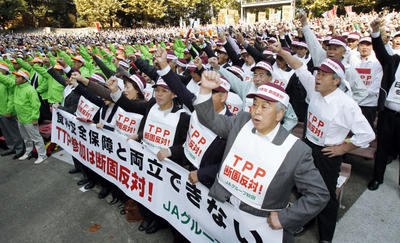The agreement will link up nine countries in three continents: Australia, Brunei, Chile, Malaysia, New Zealand, Peru, Singapore, United States and Vietnam.
The Singapore talks are going to be difficult. For most of the previous negotiations, officials have been able to talk in general terms about objectives.
But, starting in Singapore, the negotiators have to begin matching sweeping rhetoric about quality with the more dirty, sometimes challenging reality on the ground. Rather than talking in abstractions, officials are arguing over specific texts and drafting new rules that will govern trade between nine very diverse economies. This is where things get complicated and officials will confront at least two different problems.
Firstly, the nine TPP members are already linked by 25 different agreements at the bilateral or regional levels. For example, Singapore and New Zealand already have three different agreements in place for handling trade. Each of these existing agreements has slightly different provisions. Trade in services is handled differently across bilateral and regional agreements, and any new TPP arrangements have to take these existing agreements into account.
Since many of the existing trade agreements were carefully crafted to bring benefits to some groups and minimise losses for others, some of these compromises may be undone by the TPP negotiations.
Up until now, it has not been clear exactly which businesses, sectors or industries located in which countries might be affected by the new rules. As officials move to drafting texts, the picture will become much clearer by the end of the talks — and for some countries it will be harder to reach a consensus.
Secondly, given the hype surrounding the TPP, it will be difficult to live up to expectations. Some of the objectively ‘good’ ideas are now starting to run into the reality of political and economic conditions in member states.
A truly ‘high quality’ agreement would seek to reduce all tariff barriers to trade in goods to zero. This would allow exporters located in any of the nine members to send goods across the border to another member without paying any tariffs — greatly expanding market access opportunities for member state exporters and increasing the products available to consumers and producers.
But this goal presents many foreseeable problems. Although Singapore has tariff levels at zero, other TPP members do not. Depending on the product, tariff levels can be prohibitively high. Under the ASEAN-Australia-New Zealand Free Trade Agreement (AANZFTA), Malaysian tariffs on some water products and other beverages can be 15 per cent, and cement or chemicals can be subject to 18 per cent tariffs, even for partner countries receiving these preferential rates.
Kumquats (a type of citrus fruit) entering Vietnam are subject to a 40 per cent tariff for AANZFTA partner exporters through 2022 and beyond; any plans to drop tariff levels as a result of TPP negotiations are likely to be met with hostility by Vietnamese citrus farmers who may face an influx of foreign, competing products in the domestic market.
As the negotiations proceed, it will be increasingly clear how much openness will be required from which sectors. Citrus growers, bottled water distributors and cement manufacturers will soon learn whether they are included in the ‘winning’ or ‘losing’ side of this trade agreement — and how much they stand to gain or lose.
Finally, one important component of the 21st century aspirations for the TPP is a series of new issues that have not been addressed in other trade agreements. This includes topics like encouraging small and medium enterprises or streamlining regulations across member states.
Meeting in Singapore, officials have to either translate these ideas into concrete plans or jettison the topics. Negotiations have reached such urgency, with the deadline for conclusion in only eight months, that officials cannot afford to spend time on topics that will not be ready by November. But the trade-off is that abandoning, or watering down, the ambition in these horizontal issues does dilute the ‘high quality’ nature of the entire agreement.
Whether a success or failure, the Singapore round will probably be remembered as a watershed moment in the TPP negotiations — when rhetoric met reality.
Deborah K. Elms is Head of the Temasek Foundation Centre for Trade & Negotiations at the S. Rajaratnam School of International Studies (RSIS), Nanyang Technological University. An earlier version of this essay was published here, as RSIS Commentary 46/2011.


It is for their own sake that Australia, Brunei, Chile, Malaysia, New Zealand, Peru, Singapore, United States, and Vietnam, get this going as soon as possible–even any basic agreements. The point is get moving now.
Ms Wong asserts that ‘we should get going now with TPP on any terms’. Why? Some analysis of the issue would be helpful. There is absolutely no value in this initiative if it is not progressed on the right terms. If it is structured as an exclusive arrangement, full of exceptions to allow the continued protection of sensitive sectors like dairy and sugar in the United States, it will be a waste of time. If it makes it difficult for others wishing to join, it will drive divisions that will prevent not foster further economic interdependence in the region. And if it serves, as it would under those conditions, to split the region into political camps, it will be dangerous politically. Is that what Ms Wong’s sloganeering is about?
It is interesting to see what this TPP will achieve.
The number of countries is not small, but within it only the US counts as one of the largest APEC economies.
China, Japan and Korea are currently not in. The first two are world’s second and third largest economies and in the region. Both Japan and Korea are the US allies as well.
It is an interesting entity indeed, but likely to achieve little, perhaps.